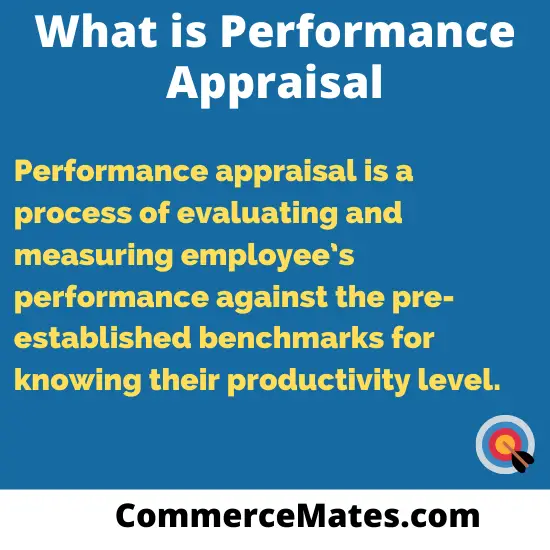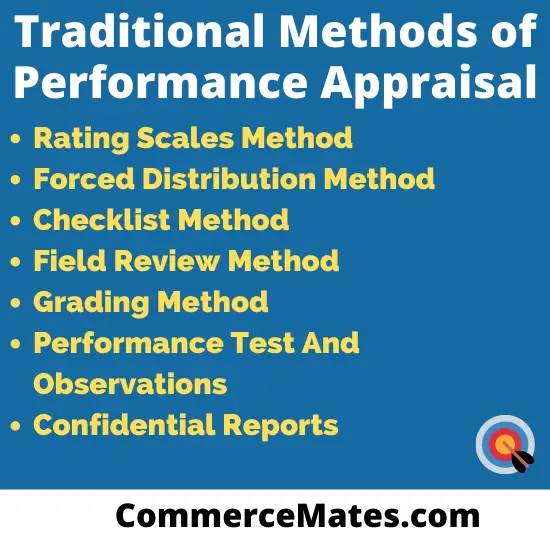Contents
What is Performance Appraisal?
Performance appraisal is a process of evaluating and measuring employee performance against the pre-established benchmarks for knowing their productivity level. It is an annual process carried out by an organization where first quantifiable goals and objectives are set, and then used for accessing the performance of individuals. The results of the performance appraisal process are used by management in determining the wages and promotion of employees. This process is quite critical for organizations as it enables them in tracking the performance of employees, which is linked directly with business long-term growth. On the other hand, it also results in boosting employee productivity and enhances their outcomes.

Traditional Methods of Performance Appraisal
The traditional methods of performance appraisal are listed below: –
Rating scales method
The rating scale method is one of the well-known traditional and widely used methods of evaluating the employee’s performance. A rating scale is developed here, in which distinct parameters are used for knowing the performance of workers. The parameters used on the scale are attitude, output, initiative, dependability, attendance, etc. which range from excellent to poor. The rating scale ranges from 1 to 10 where a low score indicates negative feedback and a high score denotes positive feedback.
Hence, every employee is given a rating against each of the criteria on the basis of their performance and then finally a consolidated score is computed. It is the easiest method of performance appraisal used in many companies such as Airtel and Dell corporation in India.
Forced distribution method
The forced distribution method is the most popular method in big organizations. This method is based on assumption that employees vary greatly from each other in terms of performance level, some are more productive and some are less productive. The rater is forced to distribute employees on a performance basis on each point of scale which is bell-shaped. In this manner, the majority of employees fall into the outstanding zone, a few into the average zone, and a few into the bottom region of the curved scale.

Checklist method
The checklist method of performance appraisal is one where a list of statements denoting the employee’s performance and characteristics on the job is prepared. Every statement has a yes or no option against them which is ticked and marked by the rater in accordance with traits possessed by the employee. After the completion of the checklist, a rater forwards this list to the HR department for final evaluation of the worker. The number of ticks directly influences the result or rating of an employee.
However, the checklist method also has various disadvantages. Firstly, it is quite a complex and difficult task to assemble, analyze and weigh many numbers of statements related to employee characteristics. Secondly, this method is inefficient requiring a lot of money, time, and effort for preparing a list of questions for every category of job.
Field review method
It is a method in which evaluation of employee performance is done by some external person not belonging to his/her own department. The person usually belongs to the HR department or is from the corporate office. Filed review method is most commonly used where the rater is found biased or his/her ratings are found higher than others. The external does a review of employee performance via his records and does interviews with his superiors and the assessee himself. The questions are raised by HR specialists from seniors regarding the performance and employment of workers.
Grading method
The grading method of performance appraisal involves the pre-establishment of distinct categories which denote worth and carefully define them. The categories established are basically of three types: outstanding, satisfactory, and unsatisfactory. Moreover, there may be more than 3 categories in some scenarios. The performance of employees is now compared with defined grades and accordingly allocated grade which best defines his/her achievements.
This type of grading system is most commonly used in candidate selection in the public service sector or the semester pattern of examinations. The main limitation of this method is that the rater may rate a majority of employees on the higher side of their performance.
Performance test and Observations
This is a performance appraisal method where distinct tests and observations are done in order to rate the employee’s performance. The test organized are either in written or oral form for determining the knowledge level and skill of employees. Many times an employee is asked by a rater to show his skills in given situations on the basis of which he/she is evaluated.
Confidential reports
A confidential report is a traditional method that is generally used by governmental organizations for appraisal purposes. The report of employees is prepared by their immediate superiors highlighting their strengths, weakness, failures, attendance, self-expression, technical ability, and main achievements. The report is prepared in a descriptive manner which forms the basis of employee promotion and transfer.
It is a simple method of performance appraisal that does not require a complex format or extensive training for proper execution. However, the major disadvantage of this method is that it is dependable more on impressions in place of data. More emphasis is made on evaluation instead of developing employees.